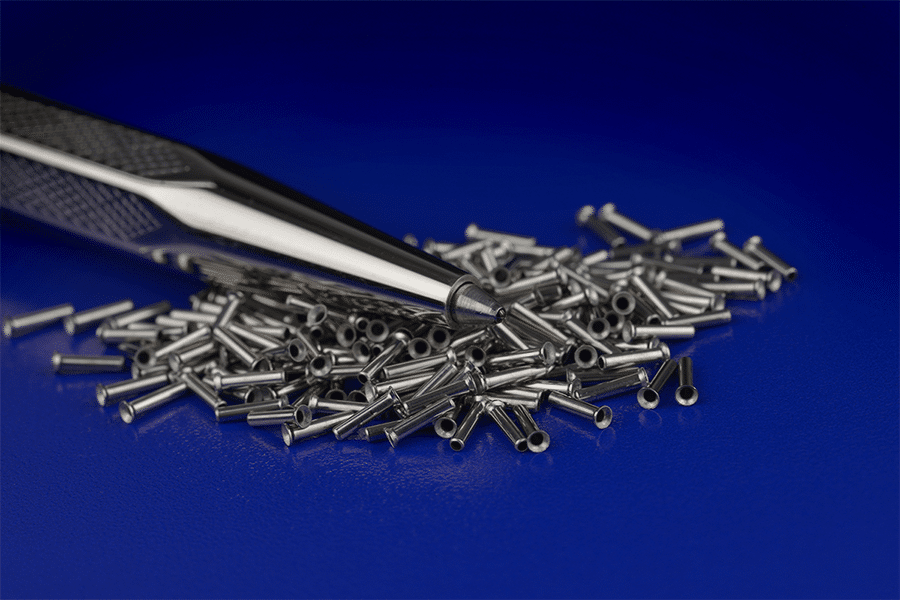No clue if this is the right forum for this question, but since I'm a machinist by profession this is where I know to go.
I've recently been playing around with making some small things for myself in my off hours, and since I have a fair bit of titanium laying around I figured I'd try to learn how to do some type 3 anodization. Since I went through the trouble of pushing my boss to help me develop a small electropolishing cell for the shop, I figured I could use the power supply to anodize as well.
I've been playing with the electrical anodization of grade 5 titanium (alloy 6Al4V), and the colors I'm getting are pretty great. I've successfully developed the entire voltage spectrum of colors, and quite vibrantly at that. I've noticed an issue with my process, however. My workpieces have some odd pitting and scarring on their surfaces that develops during the growth of the oxide layer. I have no idea what the cause might be. In my testing, I've been trying to build a general color vs voltage chart so that I can know what to expect from a given voltage within my setup. I typically set my power supply to a specific voltage, contact it with the anode to color my workpiece, record the final color that the voltage gives, then increase the voltage and repeat. After a while, the workpiece will begin to develop these dull gray scars that will also sprout an odd, white, fluffy stuff. If disturbed, the fluff will slough off and float around the electrolyte solution.
The uploader in the post form is saying my pictures are too big, so here's a link to some pictures of what I'm talking about.
I'd rather not use a hydrofluoric acid based etchant, so I'm using a heated solution of Sodium Fluoride and Ammonium Persulfate to etch my workpieces. It seems seems to work quite well, and I know it's stripping the surface of the titanium because if I toss an anodized piece into the etchant I can watch the color sequence reverse itself over time. I'm rinsing in distilled water, then anodizing in an electrolyte of Trisodium Phosphate (TSP) in distilled water using a titanium mesh cathode with a niobium anode contactor. With the power supplies we have, voltage and amperage capacities are not an issue. TSP seems to be a very common electrolyte for this purpose, so I'm very confused about what might be my issue.
Does anyone have any thoughts on what might cause these issues?
I've recently been playing around with making some small things for myself in my off hours, and since I have a fair bit of titanium laying around I figured I'd try to learn how to do some type 3 anodization. Since I went through the trouble of pushing my boss to help me develop a small electropolishing cell for the shop, I figured I could use the power supply to anodize as well.
I've been playing with the electrical anodization of grade 5 titanium (alloy 6Al4V), and the colors I'm getting are pretty great. I've successfully developed the entire voltage spectrum of colors, and quite vibrantly at that. I've noticed an issue with my process, however. My workpieces have some odd pitting and scarring on their surfaces that develops during the growth of the oxide layer. I have no idea what the cause might be. In my testing, I've been trying to build a general color vs voltage chart so that I can know what to expect from a given voltage within my setup. I typically set my power supply to a specific voltage, contact it with the anode to color my workpiece, record the final color that the voltage gives, then increase the voltage and repeat. After a while, the workpiece will begin to develop these dull gray scars that will also sprout an odd, white, fluffy stuff. If disturbed, the fluff will slough off and float around the electrolyte solution.
The uploader in the post form is saying my pictures are too big, so here's a link to some pictures of what I'm talking about.
I'd rather not use a hydrofluoric acid based etchant, so I'm using a heated solution of Sodium Fluoride and Ammonium Persulfate to etch my workpieces. It seems seems to work quite well, and I know it's stripping the surface of the titanium because if I toss an anodized piece into the etchant I can watch the color sequence reverse itself over time. I'm rinsing in distilled water, then anodizing in an electrolyte of Trisodium Phosphate (TSP) in distilled water using a titanium mesh cathode with a niobium anode contactor. With the power supplies we have, voltage and amperage capacities are not an issue. TSP seems to be a very common electrolyte for this purpose, so I'm very confused about what might be my issue.
Does anyone have any thoughts on what might cause these issues?



